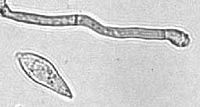
Photo from wikipedia
Anthracnose of poplar caused by Colletotrichum gloeosporioides is a leaf disease that seriously affects poplar growth. The pathogen invades the host in the form of adherent cells, which generate turgor… Click to show full abstract
Anthracnose of poplar caused by Colletotrichum gloeosporioides is a leaf disease that seriously affects poplar growth. The pathogen invades the host in the form of adherent cells, which generate turgor pressure through the metabolism of intracellular substances prior to penetrating the epidermis of poplar leaves. In this study, the expansion-related pressure of the mature appressorium of the wild-type C. gloeosporioides was approximately 13.02 ± 1.54 MPa at 12 h, whereas it was 7.34 ± 1.23 MPa and 9.34 ± 2.22 MPa in the melanin synthesis-related gene knockout mutants ΔCgCmr1 and ΔCgPks1, respectively. The CgCmr1 and CgPks1 genes were highly expressed at 12 h in the wild-type control, implying that the DHN melanin biosynthesis pathway may play an important role in the mature appressorium stage. The transcriptome sequencing analysis indicated that the upregulated melanin biosynthesis genes in C. gloeosporioides, such as CgScd1, CgAyg1, CgThr1, CgThr2, and CgLac1, are involved in specific KEGG pathways (i.e., fatty acid biosynthesis, fatty acid metabolism, and biotin metabolism). Therefore, we speculate that the melanin synthesis-related genes and fatty acid metabolism pathway genes contribute to the regulation of the turgor pressure in the mature C. gloeosporioides appressorium, ultimately leading to the formation of infection pegs that enter plant tissues. These observations may reflect the co-evolution of C. gloeosporioides and its host.
Journal Title: International Journal of Molecular Sciences
Year Published: 2023
Link to full text (if available)
Share on Social Media: Sign Up to like & get
recommendations!